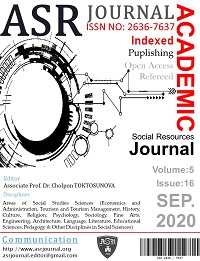INVESTIGATION OF THE RELATIONSHIP BETWEEN UNIVERSITY STUDENTS' FAMILY HARMONY AND INTOLERANCE OF UNCERTAINTY LEVELS IN THE COVID 19 PROCESS
Author :
Abstract
Bu araştırmanın amacı; evdekal çağrısı ile uzaktan eğitim gören üniversite öğrencilerinin belirsizliğe tahammülsüzlük düzeyleri ile aile uyumları arasındaki ilişkiyi farklı değişkenler açısından incelemektir. Bu çalışma ilişkisel tarama modelinde betimsel bir araştırmadır. Örneklem grubunu 2019-2020 bahar döneminde uzaktan eğitim alan 276 öğrenci oluşturmuştur. Veri toplama aracı olarak, Carleton, Norton ve Asmundson (2007) tarafından geliştirilen, Sarıçam ve ark. (2014) tarafından Türkçe’ye uyarlanan Belirsizliğe Tahammülsüzlük Ölçeği (BTÖ-12) ve Kavikondala ve arkadaşları (2015) tarafından geliştirilmiş, Duman Kula, Ekşi ve Demirci (2018) tarafından Türkçe uyarlama çalışması yapılmış olan Aile Uyum Ölçeği kullanılmıştır. Verilerin normal dağılımı nedeniyle parametrik testler uygulanılmıştır. Ayrıca öğrencilerin belirsizliğe tahammülsüzlük düzeyleri ile aile uyumları arasındaki ilişkiyi belirlemek için Pearson Korelasyon analizi kullanılmıştır. Anlamlılık düzeyi .05 olarak belirlenmiştir. Araştırmada elde edilen bulgulara göre öğrencilerin belirsizliğe tahammülsüzlük düzeyleri ve aile uyum düzeylerinin cinsiyete göre puan ortalamaları arasında erkek öğrenciler lehine anlamlı fark olduğu görülmüştür. Öğrencilerin evde kaldıkları kişi sayısına göre, belirsizliğe tahammülsüzlük ölçeğinin bütünü ile engelleyici kaygı alt boyutu puan ortalamaları arasında 2 ve daha az kişiyle kaldıklarını ifade eden öğrencilerin lehine anlamlı fark olduğu görülmüştür. Aile uyum ölçeğinin evde kalınan kişi sayısına göre puan ortalamaları arasında anlamlı fark görülmemiştir. Öğrencilerin spor yapmanın salgının oluşturduğu olumsuz etkiyi azaltıp azaltmama durumuna göre, belirsizliğe tahammülsüzlük ölçeğinin bütünü ve alt boyutları puan ortalamaları arasında salgından oldukça fazla etkilendiğini ifade eden öğrencilerin lehine anlamlı fark olduğu görülmüştür. Öğrencilerin aile uyum düzeylerinde ise spor yapmanın salgının oluşturduğu olumsuz etkiyi azalttığını düşünen öğrencilerin lehine anlamlı fark olduğu görülmüştür. Öğrencilerin günlük internet kullanım süresine göre, belirsizliğe tahammülsüzlük ölçeğinin bütünü ve alt boyutları puan ortalamaları arasında 9 saat ve daha fazla süre internet kullanan öğrencilerin lehine anlamlı fark olduğu görülmüştür. Öğrencilerin aile uyum düzeylerinde ise 2 saat ve daha az süre internet kullanan öğrencilerin lehine anlamlı fark olduğu görülmüştür. Sonuç olarak, öğrencilerin belirsizliğe tahammülsüz ölçeği ve alt boyutları puan ortalamaları ile aile uyum ölçeği puan ortalaması arasında ilişki olmadığı görülmüştür.
Keywords
Abstract
The purpose of this research is to examine the relationship between the level of intolerance to uncertainty and family harmony of university students who receive distance education with a stay at home call in terms of different variables. This study is a descriptive research in the relational survey model. The sample group consisted of 276 students who received distance education in the spring semester of 2019-2020. As a data collection tool; developed by Carleton, Norton, and Asmundson (2007) Sarıçam et al. (2014) adapted into Turkish "Intolerance of Uncertainty Scale", and developed by Kavikondala (2015) The "Family Harmony Scale" adapted into Turkish by Duman Kula, Ekşi and Demirci (2018) was used. Parametric tests were applied due to the normal distribution of the data. Also, the Pearson Correlation analysis was used to determine the relationship between students' intolerance to uncertainty and family harmony. The significance level was determined as .05. According to the findings of the study, it was observed that there was a significant difference in favor of male students between the mean scores of students' intolerance to uncertainty and family harmony levels by gender. According to the number of people staying at home, there was a significant difference between the total score of the intolerance to uncertainty scale and the obstructive anxiety sub-dimension mean scores in favor of the students who stated that they stayed with 2 or fewer people. There was no significant difference between the mean scores of the family harmony scale according to the number of people staying at home. There was no significant difference between the mean scores of the family harmony scale according to the number of people staying at home. There was no significant difference between the mean scores of the family harmony scale according to the number of people staying at home. It was observed that there was a significant difference in favor of the students who stated that they were highly affected by the epidemic, between the mean scores of the whole and sub-dimensions of the scale of intolerance to uncertainty, depending on whether the students' exercise reduced the negative impact caused by the epidemic. It has been observed that there is a significant difference in the family harmony levels of the students in favor of the students who think that doing sports reduces the negative effect caused by the epidemic. It has been observed that there is a significant difference in the family harmony levels of the students in favor of the students who think that doing sports reduces the negative effect caused by the epidemic. According to students' daily internet use time, it has been observed that there is a significant difference in favor of students who use the internet for 9 hours or more between the mean scores of the whole scale and sub-dimensions of the intolerance to uncertainty scale. It was observed that there was a significant difference in the family harmony levels of the students in favor of the students who used the internet for 2 hours or less. As a result, it was observed that there was no relationship between the mean scores of the students' intolerance to uncertainty scale and its sub-dimensions and the average score of the family harmony scale.
